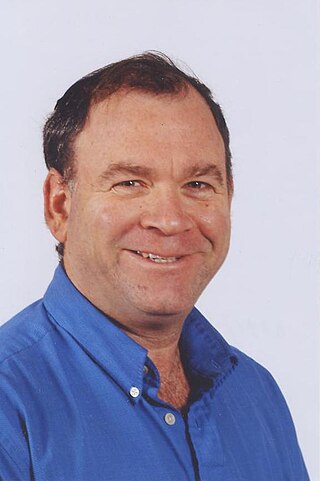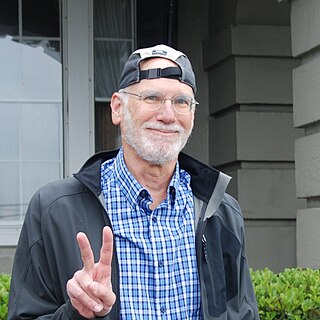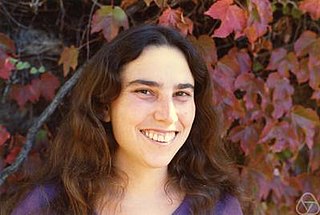Related Research Articles
In mathematics, a free abelian group is an abelian group with a basis. Being an abelian group means that it is a set with an addition operation that is associative, commutative, and invertible. A basis, also called an integral basis, is a subset such that every element of the group can be uniquely expressed as an integer combination of finitely many basis elements. For instance the two-dimensional integer lattice forms a free abelian group, with coordinatewise addition as its operation, and with the two points (1,0) and (0,1) as its basis. Free abelian groups have properties which make them similar to vector spaces, and may equivalently be called free-modules, the free modules over the integers. Lattice theory studies free abelian subgroups of real vector spaces. In algebraic topology, free abelian groups are used to define chain groups, and in algebraic geometry they are used to define divisors.

Grigory Aleksandrovich Margulis is a Russian-American mathematician known for his work on lattices in Lie groups, and the introduction of methods from ergodic theory into diophantine approximation. He was awarded a Fields Medal in 1978, a Wolf Prize in Mathematics in 2005, and an Abel Prize in 2020, becoming the fifth mathematician to receive the three prizes. In 1991, he joined the faculty of Yale University, where he is currently the Erastus L. De Forest Professor of Mathematics.
Joan Sylvia Lyttle Birman is an American mathematician, specializing in low-dimensional topology. She has made contributions to the study of knots, 3-manifolds, mapping class groups of surfaces, geometric group theory, contact structures and dynamical systems. Birman is research professor emerita at Barnard College, Columbia University, where she has been since 1973.

In Lie theory and related areas of mathematics, a lattice in a locally compact group is a discrete subgroup with the property that the quotient space has finite invariant measure. In the special case of subgroups of Rn, this amounts to the usual geometric notion of a lattice as a periodic subset of points, and both the algebraic structure of lattices and the geometry of the space of all lattices are relatively well understood.
Bass–Serre theory is a part of the mathematical subject of group theory that deals with analyzing the algebraic structure of groups acting by automorphisms on simplicial trees. The theory relates group actions on trees with decomposing groups as iterated applications of the operations of free product with amalgamation and HNN extension, via the notion of the fundamental group of a graph of groups. Bass–Serre theory can be regarded as one-dimensional version of the orbifold theory.

Zlil Sela is an Israeli mathematician working in the area of geometric group theory. He is a Professor of Mathematics at the Hebrew University of Jerusalem. Sela is known for the solution of the isomorphism problem for torsion-free word-hyperbolic groups and for the solution of the Tarski conjecture about equivalence of first-order theories of finitely generated non-abelian free groups.

Alexander Lubotzky is an Israeli mathematician and former politician who is currently a professor at the Weizmann Institute of Science and an adjunct professor at Yale University. He served as a member of the Knesset for The Third Way party between 1996 and 1999. In 2018 he won the Israel Prize for his accomplishments in mathematics and computer science.
Bhama Srinivasan is a mathematician known for her work in the representation theory of finite groups. Her contributions were honored with the 1990 Noether Lecture. She served as president of the Association for Women in Mathematics from 1981 to 1983.

Jonathan Lazare Alperin is an American mathematician specializing in the area of algebra known as group theory. He is notable for his work in group theory which has been cited over 500 times according to the Mathematical Reviews. The Alperin–Brauer–Gorenstein theorem is named after him.

Gopal Prasad is an Indian-American mathematician. His research interests span the fields of Lie groups, their discrete subgroups, algebraic groups, arithmetic groups, geometry of locally symmetric spaces, and representation theory of reductive p-adic groups.
Olga Kharlampovich is a Russian-Canadian mathematician working in the area of group theory. She is the Mary P. Dolciani Professor of Mathematics at the CUNY Graduate Center and Hunter College.

Gary Michael Seitz was an American mathematician, a Fellow of the American Mathematical Society and a College of Arts and Sciences Distinguished Professor Emeritus in Mathematics at the University of Oregon. He received his Ph.D. from the University of Oregon in 1968, where his adviser was Charles W. Curtis. Seitz specialized in the study of algebraic and finite groups. Seitz was active in the effort to exploit the relationship between algebraic groups and the finite groups of Lie type, in order to study the structure and representations of groups in the latter class. Such information is important in its own right, but was also critical in the classification of the finite simple groups, a major achievement of 20th century mathematics. Seitz made contributions to the classification of finite simple groups, such as those containing standard subgroups of Lie type. Following the classification, he pioneered the study of the subgroup structure of simple algebraic groups, and as an application went a long way towards solving the maximal subgroup problem for finite groups. For this work he received the Creativity Award from the National Science Foundation in 1991.

Ruth Michele Charney is an American mathematician known for her work in geometric group theory and Artin groups. Other areas of research include K-theory and algebraic topology. She holds the Theodore and Evelyn G. Berenson Chair in Mathematics at Brandeis University. She was in the first group of mathematicians named Fellows of the American Mathematical Society. She was in the first group of mathematicians named Fellows of the Association for Women in Mathematics. She served as president of the Association for Women in Mathematics during 2013–2015, and served as president of the American Mathematical Society for the 2021–2023 term.
Hélène Barcelo is a mathematician from Québec specializing in algebraic combinatorics. Within that field, her interests include combinatorial representation theory, homotopy theory, and arrangements of hyperplanes. She is a professor emeritus of mathematics at Arizona State University, and deputy director of the Mathematical Sciences Research Institute (MSRI). She was editor-in-chief of the Journal of Combinatorial Theory, Series A, from 2001 to 2009.
Melody Tung Chan is an American mathematician and violinist who works as Associate Professor of Mathematics at Brown University. She is a winner of the Alice T. Schafer Prize and of the AWM–Microsoft Research Prize in Algebra and Number Theory. Her research involves combinatorial commutative algebra, graph theory, and tropical geometry.
Laurie Jeanne Butler is an American physical chemist known for her experimental work testing the Born–Oppenheimer approximation on separability of nuclear and electron motions. She is a Fellow of the American Physical Society and a professor emeritus of chemistry at the University of Chicago.

Jan Saxl was a Czech-British mathematician, and a professor at the University of Cambridge. He was known for his work in finite group theory, particularly on consequences of the classification of finite simple groups.
Martin Liebeck is a professor of Pure Mathematics at Imperial College London whose research interests include group theory and algebraic combinatorics.
Debra Lynn Boutin is an American mathematician, the Samuel F. Pratt Professor of Mathematics at Hamilton College, where she chairs the mathematics department. Her research involves the symmetries of graphs and distinguishing colorings of graphs.
References
- 1 2 3 4 5 6 Searcy, Maureen (Summer 2017), "The other one: Twins Laurie and Lynne Butler—one a UChicago chemistry professor, the other a double alumna—discuss math, horses, and a college boyfriend who never got them confused", UChicago Magazine
- 1 2 3 4 Curriculum vitae (PDF), 2018, retrieved 2019-08-30
- ↑ Mathieu, Claire (November 2, 2011), "Lynne Butler on academic life", A CS Professor's blog
- 1 2 Lynne Butler at the Mathematics Genealogy Project
- 1 2 Selvin, Paul (March 1992), "Profile of a Field: Mathematics – Heroism Is Still The Norm", Science, 255 (5050): 1382–1383, doi:10.1126/science.255.5050.1382, JSTOR 2876390, PMID 17801224
- ↑ Marsa, Linda (November 1992), "Doing Science Off The Beaten Path At Liberal Arts Schools", The Scientist
- ↑ Mays, Michael E. (1988), "Review of A unimodality result in the enumeration of subgroups of a finite abelian group", Mathematical Reviews, MR 0911049
- ↑ Morris, A. O. (1995), "Review of Subgroup Lattices and Symmetric Functions", Mathematical Reviews, MR 1223236
- ↑ Faculty profile: Lynne Butler, Haverford College, retrieved 2019-08-30
- ↑ Garrison, Barbara (November 18, 2002), "Math professor explains John Nash's Nobel Prize-winning theory", University of Delaware Daily